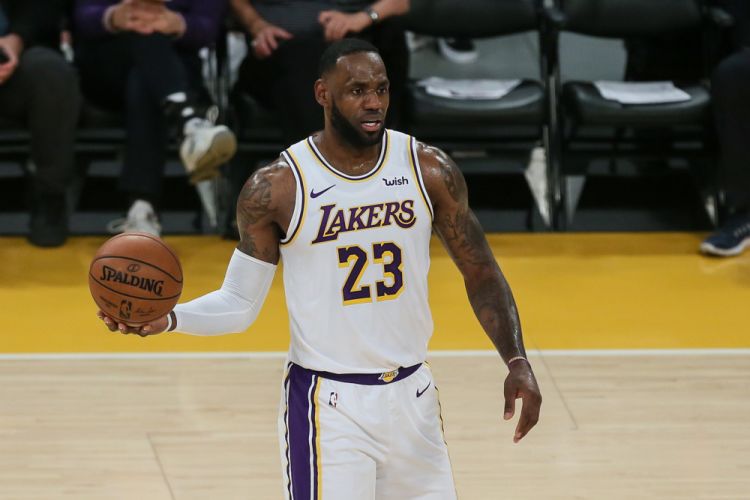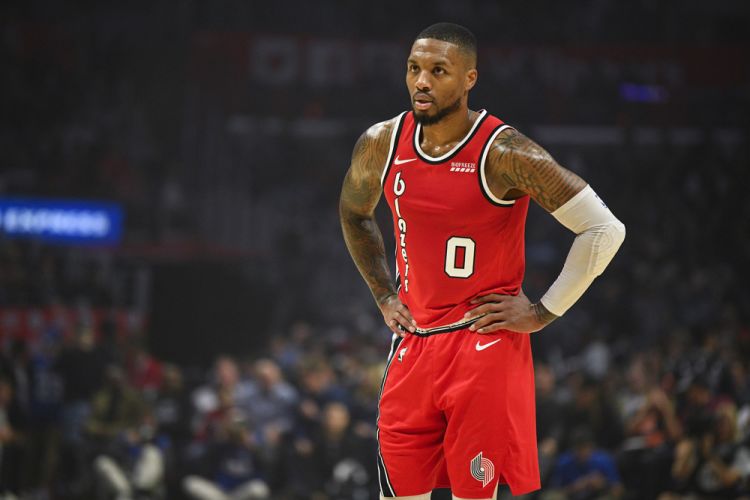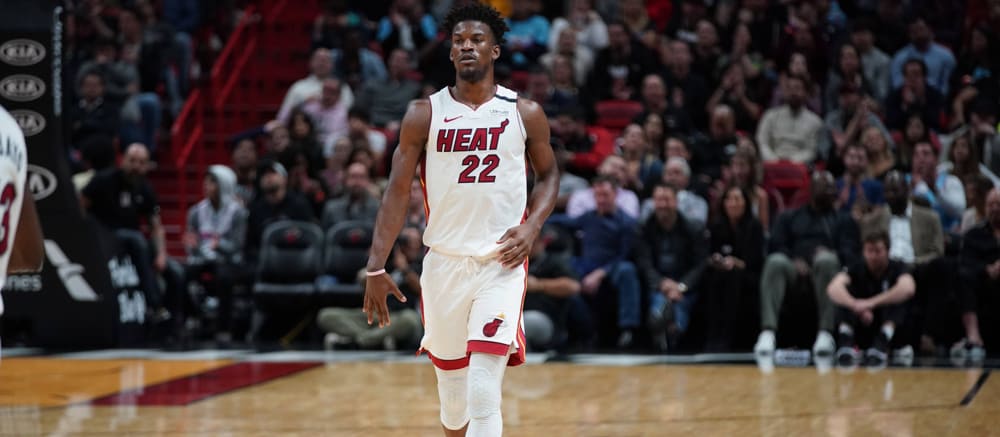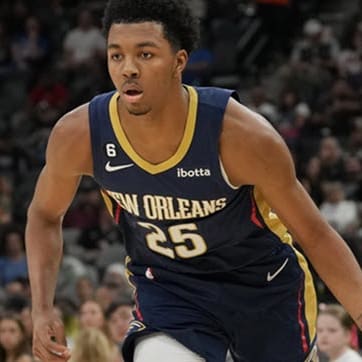This article is part of our NBA Draft Kit series.
As the start of the NBA season creeps closer, the reality of planning and executing a full season outside of a bubble environment is beginning to set in.
Last week, the league issued a comprehensive health and safety protocol for the 2020-21 season in the form of a 134-page document. While that may seem excessive, the range of challenges and liabilities the NBA is preparing to accept over the next several months is massive.
Thanks largely to an exhaustingly thorough testing and quarantine protocol, the NBA was able to pull off the Orlando bubble with tremendous success. No players tested positive for COVID-19 at Walt Disney World, and the league was even able to safely bring family members and close friends into the bubble during the postseason.
But without the isolation of a (mostly) impermeable bubble at a deserted theme park, the NBA is opening itself up to many of the issues faced by the NFL and Major League Baseball over the past several months. From traveling through airports, to monitoring activity on the road and away from team facilities, the undertaking will be an even longer and much more complex high-wire act than the Orlando bubble.
To the league's credit, it's done well to temper expectations and acknowledge that it's highly unlikely the season carries on without significant interference by the COVID-19 pandemic. Protocols are already in place, like the schedule being deliberately designed to account for the potential of postponed or canceled games.
On Friday, the league released
As the start of the NBA season creeps closer, the reality of planning and executing a full season outside of a bubble environment is beginning to set in.
Last week, the league issued a comprehensive health and safety protocol for the 2020-21 season in the form of a 134-page document. While that may seem excessive, the range of challenges and liabilities the NBA is preparing to accept over the next several months is massive.
Thanks largely to an exhaustingly thorough testing and quarantine protocol, the NBA was able to pull off the Orlando bubble with tremendous success. No players tested positive for COVID-19 at Walt Disney World, and the league was even able to safely bring family members and close friends into the bubble during the postseason.
But without the isolation of a (mostly) impermeable bubble at a deserted theme park, the NBA is opening itself up to many of the issues faced by the NFL and Major League Baseball over the past several months. From traveling through airports, to monitoring activity on the road and away from team facilities, the undertaking will be an even longer and much more complex high-wire act than the Orlando bubble.
To the league's credit, it's done well to temper expectations and acknowledge that it's highly unlikely the season carries on without significant interference by the COVID-19 pandemic. Protocols are already in place, like the schedule being deliberately designed to account for the potential of postponed or canceled games.
On Friday, the league released only the first half of the 2020-21 schedule, providing itself with the flexibility over the final months of the season to account for any pre-All-Star-break alterations.
For fantasy basketball players, the season is shaping up to be perhaps the most challenging of all-time. The challenges brought on by the pandemic will force managers to be sharper and more tuned-in than ever. And with a condensed schedule, the margin for error will be razor thin.
The Schedule
Released in part on Friday, the schedule for the NBA season will pack 72 games for all 30 teams into roughly a five-month period. The play-in tournament -- one of the major successes to come out of the Orlando bubble -- is back for Year 2 and is set to run from May 18-21. For fantasy players, the tournament, itself, is unlikely to have any fantasy ramifications, but one silver lining is it should keep more teams competitive into April and May -- at least that's the working theory.
Taking a look at the schedule, it's a pretty close facsimile to what NBA fans have come to know in recent years, with a few key tweaks. First and foremost, the league has trimmed 10 games from the schedule -- saving roughly three weeks of regular-season time. Teams will still play all 29 opponents at least once at home and on the road, but they will face off against teams in their own conference just three times -- down from the usual four.
Travel-wise, there's only so much the NBA can do. The 76ers still need to fly cross-country to play in Portland, and the Suns still have to head all the way over to Toronto Tampa Bay to take on the Raptors. So even with a schedule that emphasizes conference opponents, the reality of geography -- Memphis and Golden State are both in the West -- will take its toll. To help combat this, the schedule was designed to limit long-distance travel as much as possible. On top of that, teams will play a number of baseball-style "series", where they'll face the same opponent consecutively over a two or three day span.
Per the league's official release on Friday: The schedule incorporates steps to reduce travel, including the use of a "series" model. In some instances where a team is scheduled to play twice in one market, those games have been scheduled to be played consecutively. Each team will play an average of four "series" in the First Half – two at home and two on the road. Additional steps include more instances of teams playing consecutive road games against teams that are geographically close, and roughly 50% fewer instances of teams making single-game road trips.
In terms of fantasy basketball, the emphasis on reduced travel has to be viewed as a positive, but it comes with a trade-off. In recent years, the NBA has made strides to accommodate players' requests to limit back-to-backs and provide as many rest days as possible between games. But this season, all of that is going out the window -- the NBA has no choice. Squeezing in 1,080 games in five months means condensing the schedule, so over the first half of the season, two-game weeks are virtually non-existent. During the nine full weeks between the start of the season and the All-Star break, only three teams -- Minnesota, Washington, Dallas -- have a two-game week. Virtually every team is scheduled to play three or four games every week during the season's first half.
On one hand, this all but eliminates the frustration of having a star player on a two-game week. But on the other, an injury or positive COVID test could knock players out for a larger chunk of the schedule. If a player is set to miss four weeks, he'll be almost guaranteed to forfeit 15 games -- more than 20 percent of the regular season.
While the schedule does feature more back-to-backs, the uptick will be relatively minimal. Where the league is instead making up ground is by eliminating longer rest stretches -- periods of three or four days without a scheduled game. Instances of multiple days off between games are few and far between, while three days of rest between games is almost non-existent, save for a few exceptions.
Load Management
Fantasy-wise, having most of your roster on a four-game week, along with a few three-game players, should be a positive. But with the league likely to be at least somewhat amenable to load management, it's highly likely that even the NBA's most durable stars will take a few nights off. This will be especially true for a number of the league's marquee veterans -- and fantasy producers.
LeBron James, whose Lakers played into October in Orlando, openly pushed for the season to start in January or February and made it clear that he plans to take it easy -- by his standards -- during the regular season. With James leading the way, other stars will likely follow suit, especially as the emphasis on being healthy for the playoffs continues to increase with each passing season.

The NBA did push back on this notion on Monday, when it released a memo detailing restrictions on resting healthy players (covered in-depth here). While the league will crack down on sitting healthy stars during nationally televised games and sitting multiple stars for the same game, the bottom line is there will still be plenty of opportunity for teams to find rest nights.
Included in Monday's memo is a note regarding flexibility for teams that advanced deep into the 2020 postseason. While those teams are still strongly discouraged from resting players on national television, the league is expected to be more lenient when it comes to stars like LeBron James, Anthony Davis, and Jimmy Butler, whose offseason will barely span two months after playing into mid-October in Orlando. In a normal league year, players who reach the Finals would have roughly a four-month offseason.
One interesting wrinkle to keep an eye on this season: will certain teams benefit from opponents resting stars? With teams being told not to rest players for national TV games, as well as road games, the pool of potential rest nights begins to shrink for teams with a high number of national TV games. Given that the league tends to set matchups between two high-profile teams for its marquee games, many rest nights for players like James, Butler, Kawhi Leonard, and Kevin Durant could come at home against lower-level opponents, as those games are unlikely to be nationally televised.
The Waiver Wire
Meticulously working the waiver wire will be more important than ever this season. This will especially be the case in leagues that allow daily -- as opposed to weekly -- roster moves. Just because a player goes into a week with four games doesn't mean he'll play all four. Fantasy managers who are mindful of the schedule and track potential load management pitfalls will have a leg up on those who set their lineup for the week and forget about it. Having capable backups in place at multiple positions, and maintaining a deep roster of use-able players, will be key.
The NBA is yet to clarify the protocol for a mass outbreak. Games can be canceled or postponed, but as the NFL and MLB have demonstrated, if the show can go on, it will go on. In the event a group of players, or even an entire team, suffers a COVID-19 outbreak, teams could be forced to dig deep into their benches or perhaps even lean on G League players. That doesn't mean you should target the leading scorer for the Greensboro Swarm in Round 5 of your draft, but it's a good idea to have at least some baseline familiarity with end-of-the-bench players who could prove valuable as streamers later in the season.
Injury Concerns
In conjunction with the condensed schedule comes an increased risk of injury. After all, the league's recent effort to eliminate back-to-backs and space out games was intended to reduce the possibility of players over-exerting themselves and, in turn, become more susceptible to injury.
With that crusade on hold for a year, teams are bracing for an increase in soft tissue injuries, in particular. It's impossible to pinpoint which players will be affected, but in general, those who were already injury liabilities during a normal season -- think Kyrie Irving, Blake Griffin, Joel Embiid and Kristaps Porzingis -- will make for even riskier fantasy investments. In addition, players returning from a serious injury, like Kevin Durant, John Wall, and DeMarcus Cousins, may be subject to stricter workload limits as they return to NBA competition for the first time in well over a calendar year.
COVID Protocols
Finally, the biggest hurdle fantasy basketball managers will face this season: players testing positive for COVID-19. While this was not an issue in the NBA bubble, the league simply won't have nearly the same level of control this time around. While players will be heavily restricted as to where they can eat, gather, and travel during the season, the fact remains that the NBA simply can't monitor 400-plus players around-the-clock for five months. It's inevitable that positive tests will occur.
In its health and safety protocols guide, the NBA details the procedures for players who test positive for the virus:
Players who test positive but are asymptomatic must:
- Sit out for 10 days from when first positive test occurs
- Pass a cardiac screening
- Work out alone at team facility for two days
Players who test positive and are symptomatic must:
- Sit out for 10 days from when symptoms subside
- Pass a cardiac screening
- Work out alone at team facility for two days

Players can also utilize a series of negative tests to pass through COVID-19 protocol, but the bottom line is this: Any player who tests positive will miss 12 days, at the absolute minimum. And players who exhibit symptoms could easily miss significantly more time.
It's also worth noting that even players who are asymptomatic may not work out -- either at home or at team facilities -- during their quarantine period. So while a player could ostensibly feel fine and return in less than two weeks, he likely wouldn't do so at 100 percent after spending a week-and-a-half away from the gym.
Furthermore, teams will be subject to a rigorous process when a player tests positive. Per the league's protocols, teams must report the positive result to local authorities, contact trace all close contacts, clean and disinfect its arena and/or practice facility, as well as provide isolation housing for the player who tested positive.
Fantasy managers should be most concerned about the contact tracing component, as any player who tests positive will almost certainly have interacted with other players within the last 24 to 48 hours. It will be crucial to discuss with your league manager how these situations will be handled, from a roster standpoint. One option could be to add an additional IR spot for players who test positive.
Players Most Affected
Again, it's impossible to project which players might suffer significant injuries, much less which could test positive for the virus throughout the season. However, pandemic aside, a number of players were already set to enter 2020-21 with some durability or workload concerns, which will only be exacerbated under the season's unique circumstances:
Kevin Durant: By all accounts, Durant has been back at full strength for a while now, but it's tough to imagine the Nets throwing him back into the fire without any restrictions. It's likely Durant will sit one half of back-to-back sets, and the Nets will probably build in some additional rest days -- especially if things go well early on.
John Wall: Wall hasn't played in nearly two full years, so he was going to be a major risk no matter what. With fewer breaks in the schedule, he's a candidate to have his workload carefully managed as he adjusts to playing alongside James Harden.
LeBron James: Shortly after The Finals, James all but ruled himself out for the first month of the season. He may have been half-joking, but it was clear James wasn't keen on starting a new season just two months after sealing his fourth NBA title. Don't count on James missing the Lakers' marquee dates on opening night and Christmas Day, but after Week 1 he'll likely look to coast as much as he can in Year 17.
Kyrie Irving: Irving's durability concerns reached a zenith last season when he appeared in only 20 games. He's back healthy after a long layoff, but Irving has missed at least 15 games in four of the last five seasons. For Irving, load management is less of a concern than the possibility of an actual injury.
Kawhi Leonard: The poster boy for load management, Leonard has managed his body more meticulously than any player over the last two seasons. Don't expect that to change in 2020-21, with the Clippers focused squarely on winning in the postseason.
Kristaps Porzingis: A concerning list of early-career injuries grew even longer last season, as Porzingis ended the campaign with surgery to repair a torn meniscus. Already set to miss the first few weeks of the season, Porzingis should get plenty of nights off as the Mavs ease him back into the fold.
Blake Griffin: At this point in his career, Griffin might be the biggest injury risk in all of fantasy basketball. Like Irving, load management has never been a concern -- for Griffin, it's been a troublesome knee that required yet another surgery back in January. He's fully healthy entering the season, but expecting Griffin to hold up during a first half when the Pistons have only two instances of back-to-back rest days is a big ask.
Chris Paul: Thanks in part to switching to a plant-based diet, Paul defied the odds and missed only two games last season. If he can do that again, the Suns will have an excellent shot to make the playoffs in a super-competitive Western Conference. But given his track record, the odds aren't in Paul's favor. Look for the Suns to be proactive about managing Paul's workload -- and likely his minutes load -- during the first half of the season.
Giannis Antetokounmpo: The reigning two-time MVP has been extremely durable thus far in his NBA career, and if it were up to him, he'd probably want to play all 72 games. Already, Milwaukee has effectively managed its superstar's minutes -- taking it to borderline-extreme levels last season -- but with the Bucks' focus now squarely on the postseason, it wouldn't be a surprise if they build in more rest for Antetokounmpo. This could be particularly true if Milwaukee is once again a dominant force in the East and thus has the cushion to allow Antetokounmpo to sit without the fear of sliding in the standings.










